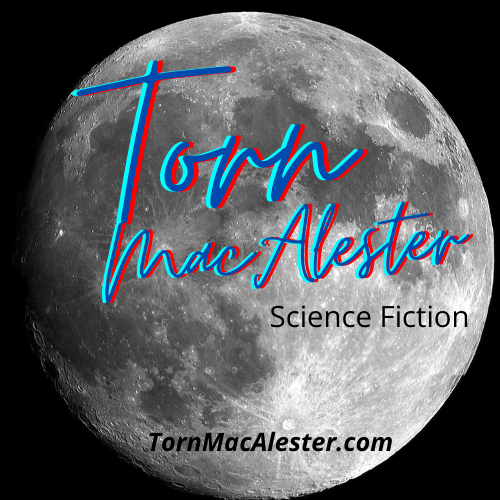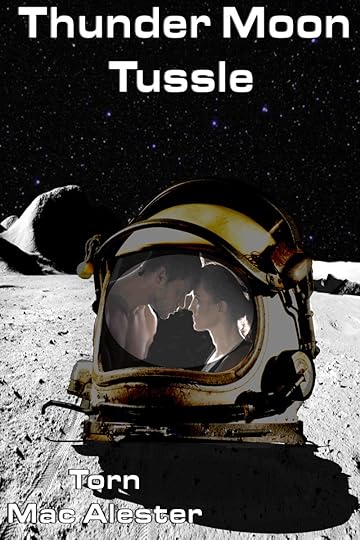Torn’s Science, Technology, & Science Fiction 1–7 May 2023
 Featured Science Fiction and the Drake Equation
Featured Science Fiction and the Drake EquationI started thinking about one of the classic authors of science fiction, and the setting he created for some of his stories. I often wondered what the implications for the Drake equation would be in that particular setting. I’ve taken a subset of the stories for this setting, since not all of the story settings are self-consistent. Let me review the three conditions from four books:
Humanity discovers that there are ancient alien civilizations on both Mars and Venus.Life is found on Ganymede.The first two interstellar locations visited by humanity have life, and one of them has an alien civilization.This is a significant difference from our recent discussions about the Drake equation applied to the universe as we know it.
Lets first look at the probability of life.
In the stories, there is no indication of there being life on the Moon other than the life in the domed colonies that humanity put there. There is also no indication of life on any other of Jupiter’s moons, nor any of Saturn’s.
Assuming we only count Io, Europa, and Calisto from Jupiter, and Titan from Saturn, we have a total of 4 bodies with life and 5 bodies without. This gives a chance of a planet having life at 44.4%.
Next, we look at the probability of planets having life also having intelligent life.
With Venus, Earth, and Mars all having intelligent life, it follows that 0.75 of all life bearing planets have life evolving to intelligence. If we include the other two planets from outside the solar system, we find four out of five planets, or 80%.
Extending this to the galaxy, we move on to attempt finding the number of civilizations that are present.
The initial value for the probability of a star having planets at roughly the time these stories was written is about 0.1; however, we have the fact that at least two stars have planets besides the Sun. This can be excepted as true since we don’t have enough evidence to set it at any other value. (Note: the author’s later work introduced a multitude of worlds but the all supported life, but this really didn’t talk about all stars or all worlds within the solar systems).
The number of planets within such a system is an average of nine, one, and one (I don’t recall seeing additional planets mentioned in these systems). We’ll set that average to be 4.
The fractional number of worlds having life is 0.44, and the fraction having intelligent life is 0.8.
The fraction of those civilizations having the ability for interstellar communications will be assumed to be 0.5, only Earth and Mars.
This give f*(0.1)*(4)*(0.44)*(0.8)*(0.5)*L, where f is the stellar formation rate and L is the lifetime of the technological civilization. Thus the number of civilizations in the galaxy is f*L*(0.07). Given that the stars form approximately 1 per year, and that we take the lifetime of a civilization to be a million years (using the fact that Mars was on the verge of collapse after a million years), we can now estimate that in this author’s milky way galaxy would contain 70 thousand civilizations.
For details of this calculation see my article on the Drake Equation:
The Drake EquationIntroduction: Drake equation developed the equation: where is the rate of star formation, is the fraction of stars that have planets, average number of planets per star that could support life, is the fraction of planets that have life, is the fraction having intelligent life, is the fraction that develops sufficient technology, and is the […]Mind you, it’s been a while since I read the four books mentioned above. For those wanting to look for themselves for something I have missed, they are: Between Planets, Farmer in the Sky, Universe/Common-Sense, and Methuselah’s Children by Robert A. Heinlein. Another Novel of his, that is in one way contradictory to the others, seems to nail the idea of the galaxy having thousands of civilizations: Have Spacesuit Will Travel.
This week’s discord chat Week of May 7 2023 [7th at 1 PM EDT (6 PM GMT), 10 9 PM EDT (11th 2AM GMT)]The Drake Equation and a Classic Science Fiction UniverseWeek of Mar 14 2023 [14th at 1 PM EDT (6 PM GMT), 17th at 9 PM EDT (18th 2 AM GMT)]TBD Torn’s Discord Server Currently ReadingEmbers of War by Gareth L. Powell
The Space Environment: Implications for Spacecraft Design — Revised and Expanded Edition by Alan C. Tribble
Lunar Sourcebook: a Users Guide to the Moon edited by Grant H. Heiken, David T. Vaniman, and Bevan M. French
Recently Read
2001: A Space Odyssey by Arthur C. Clarke
Destination—Death by Wilber S. Peacock
The New Frontiers Series, Book One: The Ship by Jack L. Knapp
Thunder Moon Tussle by Torn MacAlester available on Amazon.com
 Thunder Moon Tussle Trailer A new novel by Torn MacAlesterThe long awaited sequel to
Thunder Moon Tussle
:
Mask of the Joyful Moon
Coming Soon [image error] [image error]
Thunder Moon Tussle Trailer A new novel by Torn MacAlesterThe long awaited sequel to
Thunder Moon Tussle
:
Mask of the Joyful Moon
Coming Soon [image error] [image error] In the days of grant driven science, it is nice to see the lone independent researcher still making a contribution. Imagine taking this far into the future while checking out this article from the Lunar and Planetary Institute.
 Citizen Science in Planetary Exploration: Part 1 — LPIBNote from the Editors: In this two-part series we explore the role that citizen scientists (or amateur astronomers) play in supporting planetary exploration in the U.S. and internationally. In Part 1, Drs. Nick Lang and Michael Kelley explore the active programs that NASA uses to engage directly wit…This Week’s Short Fiction by Torn MacAlester
Citizen Science in Planetary Exploration: Part 1 — LPIBNote from the Editors: In this two-part series we explore the role that citizen scientists (or amateur astronomers) play in supporting planetary exploration in the U.S. and internationally. In Part 1, Drs. Nick Lang and Michael Kelley explore the active programs that NASA uses to engage directly wit…This Week’s Short Fiction by Torn MacAlester This week’s short fiction is the vignette Rejection.
 RejectionBy Torn MacAlester Photo by Life Of Pix from Pexels “Deputy Miller, a serious situation has risen.” Alex said, cleaning a lunar beer mug as he spoke. “Like what?” Miller answered, clearly disinterested in the Conrad Station barkeep’s current crisis. She checked her watch. Miller knew Nils Carmike’s schedule like the back of her hand. He would soon […]Electrical Charges
RejectionBy Torn MacAlester Photo by Life Of Pix from Pexels “Deputy Miller, a serious situation has risen.” Alex said, cleaning a lunar beer mug as he spoke. “Like what?” Miller answered, clearly disinterested in the Conrad Station barkeep’s current crisis. She checked her watch. Miller knew Nils Carmike’s schedule like the back of her hand. He would soon […]Electrical Charges This activity may suggest modification of terms in the Drake Equation:
 Newly discovered electrical activity within cells could change the way researchers think about biological chemistryThe human body relies heavily on electrical charges. Lightning-like pulses of energy fly through the brain and nerves and most biological processes depend on electrical ions traveling across the membranes of each cell in our body.
Newly discovered electrical activity within cells could change the way researchers think about biological chemistryThe human body relies heavily on electrical charges. Lightning-like pulses of energy fly through the brain and nerves and most biological processes depend on electrical ions traveling across the membranes of each cell in our body.
A large hunk of the asteroid that is responsible for the biggest crater in the solar system remains imbedded in the mantle of the Moon.
 Mass anomaly detected under the moon’s largest craterA mysterious large mass of material has been discovered beneath the largest crater in our solar system—the Moon’s South Pole-Aitken basin—and may contain metal from the asteroid that crashed into the Moon and formed the crater, according to a Baylor University study.
Mass anomaly detected under the moon’s largest craterA mysterious large mass of material has been discovered beneath the largest crater in our solar system—the Moon’s South Pole-Aitken basin—and may contain metal from the asteroid that crashed into the Moon and formed the crater, according to a Baylor University study.The post Torn’s Science, Technology, & Science Fiction 1–7 May 2023 appeared first on Torn Macalester.



